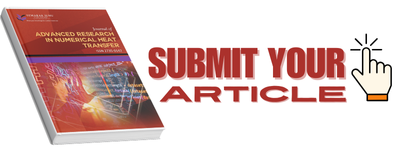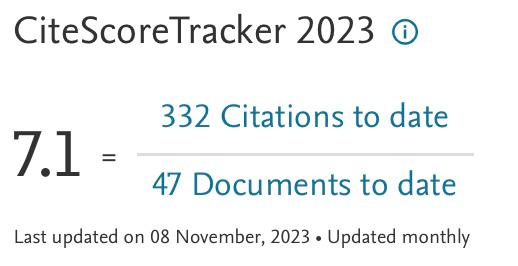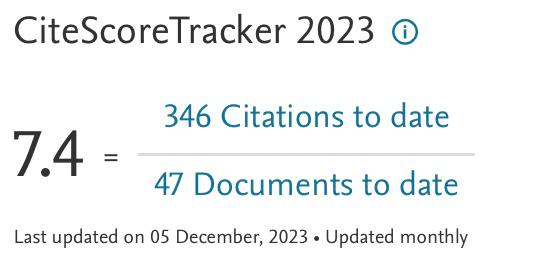Numerical Analysis on Frictional Heat Effect in Polyether-Ether-Ketone (PEEK)/Steel Pair by using OpenFOAM Model
DOI:
https://doi.org/10.37934/arnht.21.1.113Keywords:
OpenFOAM, PEEK materials, Reducing PEEK, Heat transfer, Friction and wear, Sliding bearingAbstract
The PEEK material has been applied to a sliding bearing system in a power plant system because of its high mechanical durability. In the solid friction of the PEEK materials, the frictional heat becomes the important factor because the temperature increase due to the frictional heat causes the rapid increase of the frictional coefficient of the specimen. To maintain the low frictional coefficient of the PEEK materials, an effective cooling method for the PEEK materials needs to be developed. In this study, the passive cooling method, which attaches the heat sink to the PEEK materials, was suggested. For evaluating the suggested cooling method of the PEEK materials, the calculation model adopting OpenFOAM, which is open-source software, has been developed. Adopting some functions and libraries of OpenFOAM, the frictional heat, heat resistance, and heat transfer coefficient on the heat sink were modelled. The sliding bearing experiment was conducted and time variation of the temperature and friction coefficient in the ring specimen were measured. The temperature variation in the ring specimen was compared with the calculation result. From the numerical calculation results, the developed calculation model could simulate the temperature-time variation of the ring obtained in the experiment, when the variation of the frictional coefficient, heat resistance, and heat transfer coefficient was modelled appropriately. Based on the friction and wear test results, by applying a heat dissipation mechanism to the ring test piece, the calorific value of the PEEK material can be reduced, and it is stable. It was suggested that the friction was maintained.
Downloads
References
Kurdi, A., Kan, W.H., and Chang, L. “Tribological Behaviour of High-Performance Polymers and Polymer Composites at Elevated Temperature.” Tribology International 130 (2019): 94–105. https://doi.org/10.1016/j.triboint.2018.09.010
Urmi, W.T., Rahman, M.M., Safiei, W., Kadirgama, K., and Maleque, M.A., “Effects of Minimum Quantity Lubrication Technique in Different Machining Processes - A Comprehensive Review.” Journal of Advanced Research in Fluid Mechanics and Thermal Sciences 90. No. 2 (2022), 135–159. https://doi.org/10.37934/arfmts.90.2.135159
Chang, L. Zhang, Z. Ye, L. Friedrich, K. “Tribological Properties of High-Temperature Resistant Polymer Composites with Fine Particles.” Tribology International 40, no.7 (2007): 1170–78. https://doi.org/10.1016/j.triboint.2006.12.002
Myshkin, N.K., Petrokovets, M.I. and Kovalev, A.V. “Tribology of Polymers: Adhesion, Friction, Wear, and Mass-Transfer.” Tribology International 38, no. 11-12 (2005): 910–21. https://doi.org/10.1016/j.triboint.2005.07.016
Safiei, W., Rahman, M.M., Yusoff, A.R., Tasnim, W., and Malek, Z.A.A., “Evaluation of Cutting Force in End Milling Process of Aluminium Alloy 6061-T6 Using Tungsten Carbide Inserts with MQL Method Utilizing Hybrid Nanofluid.” Journal of Advanced Research in Fluid Mechanics and Thermal Sciences 84, no. 1 (2021): 111-125. https://doi.org/10.37934/arfmts.84.1.111125
Rasep, Z., Muhammad Yazid, M.N.A.W., Samion, S., & Sidik, N.A.C., “Potential of RBD Palm Oil as a Lubricant in Textured Journal Bearing using CFD with Consideration of Cavitation and Conjugate Heat Transfer.” CFD Letters, 14, no.2 (2022): 98–110. https://doi.org/10.37934/cfdl.14.2.98110
Xiao, S. and Sue, H.-J. “Effect of Molecular Weight on Scratch and Abrasive Wear Behaviors of Thermoplastic Polyurethane Elastomers.” Polymer 169 (2019): 124–30 https://doi.org/10.1016/j.polymer.2019.02.059
Quan, D., Deegan, B., and Binsfeld, L. “Effect of Interlaying UV-Irradiated PEEK Fibres on the Mechanical, Impact and Fracture Response of Aerospace-Grade Carbon Fibre/Epoxy Composites.” Composites Part B: Engineering 191 (2020): 107923. https://doi.org/10.1016/j.compositesb.2020.107923
Akagaki, T., Kuraoka, Y., Takeo, F., Furuya, K. and Kawabata, M. “Effects of PEEK’s Surface Roughness on Seizure Behaviors of PEEK/Steel Pairs under Oil-Lubricated Sliding Contacts.” Mechanical Engineering Journal 4, no. 5 (2017): 17-0001517-00015. https://doi.org/10.1299/mej.17-00015
Akagaki, T., Nakamura, T. Hashimoto, Y and Kawabata, M. “Effects of Material Combinations on Friction and Wear of PEEK/Steel Pairs under Oil-Lubricated Sliding Contacts.” Journal of Physics: Conference Series, 843, (2017): 012071. http://dx.doi.org/10.1088/1742-6596/843/1/012071
Mir, A.H. and Charoo M.S. “Friction and Wear Characteristics of Polyetheretherketone (PEEK): A Review.” IOP Conference Series: Materials Science and Engineering 561, no. 1 (2019): 012051. DOI:10.1088/1757-899X/561/1/012051
Tian, Renjie, Guangming Zhu, Yuwei Lv, Taotao Wu, Tianning Ren, Zhiliang Ma, and Shuang Zhang. “Experimental Study and Numerical Simulation for the Interaction between Laser and PEEK with Different Crystallinity.” High Performance Polymers 33, no. 8 (2021): 851–61. https://doi.org/10.1177/0954008321996771
Zaman, I., Khalid, A., Manshoor, B., Araby, S., Ghazali, M.I. “The Effects of Bolted Joints on Dynamic Response of Structures.” IOP Conference Series: Materials Science and Engineering 50, no. 1 (2013): 012018. http://dx.doi.org/10.1088/1757-899X/50/1/012018
Akagaki, T., and Kawabata, M. “Effects of Counterface Surface Roughness on Friction and Wear of PEEK Materials under Oil-Lubricated Conditions.” Tribology Online 11, no. 3 (2016): 494–502. DOI:10.2474/trol.11.494
Akagaki, T., and Kawabata, M. (2010). “Seizure of PEEK and Its Composite at High Sliding Velocity in Oil Lubrication.” In Advance Tribology, 378–83. Berlin: Springer. https://doi.org/10.1007/978-3-642-03653-8_118
Zhang, G., Wetzel, B., Jim, B. and Oesterle, W. “Impact of Counterface Topography on the Formation Mechanisms of Nanostructured Tribofilm of PEEK Hybrid Nanocomposites.” Tribology International 83 (2015): 156–65. https://doi.org/10.1016/j.triboint.2014.11.015
Khalid, A., Azman, N., Zakaria, H., Manshoor, B., Zaman, I., Sapit A. and Leman A.M. “Effects of Storage Duration on Biodiesel Properties derived from Waste Cooking Oil.” Applied Mechanics and Materials 554, (2014) https://doi.org/10.4028/www.scientific.net/AMM.554.494
Wang, Q-H., Xue, Q-J., Liy, W-M. and Chen, J-M. “The Friction and Wear Characteristics of Nanometer SiC and Polytetrafluoroethylene Filled Polyetheretherketone.” Wear 243, no. 1-2 (2000): 140–46. https://doi.org/10.1016/S0043-1648(00)00432-4
Kovalenko, P., Perepelkina, S. and Korakhanov, T. “Investigation of Tribological Properties of Friction Pairs Duralumin – Fluoropolymer Used for Design and Manufacturing of Biomechatronic Devices.” Tribology in Industry 39, no. 2 (2017): 192–97. DOI:10.24874/ti.2017.39.02.05
Khalid, A., Mudin, A., Jaat, M., Mustaffa. N., Manshoor, B., Ali, M.F.M., Razali, M.A., Ngali, Z., “Effects of Biodiesel Derived by Waste Cooking Oil on Fuel Consumption and Performance of Diesel Engine.” Applied Mechanics and Materials 554, (2014): 520-525. DOI:10.4028/www.scientific.net/AMM.554.520
Manshoor, B., Jaat, M., Izzuddin, Z., and Khalid, A. “CFD Analysis of Thin Film Lubricated Journal Bearing.” Procedia Engineering 68 (2013): 56–62. https://doi.org/10.1016/j.proeng.2013.12.147
Ovaert, T.C., and Cheng, H.S. “Counterface Topographical Effects on the Wear of Polyetheretherketone and a Polyetheretherketone-Carbon Fiber Composite.” Wear 150 (1991): 275–87. https://doi.org/10.1016/0043-1648(91)90323-MGet rights and content
Robertson, E., Choudhury, V., Bhushan, S. and Walters, D.K. “Validation of OpenFOAM Numerical Methods and Turbulence Models for Incompressible Bluff Body Flows.” Computers & Fluids 123 (2015): 122–45. https://doi.org/10.1016/j.compfluid.2015.09.010




























